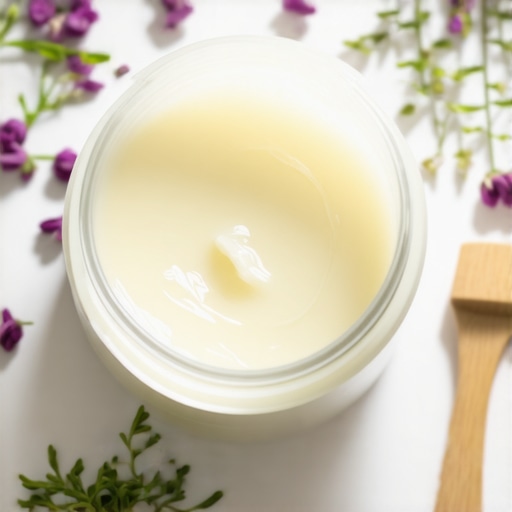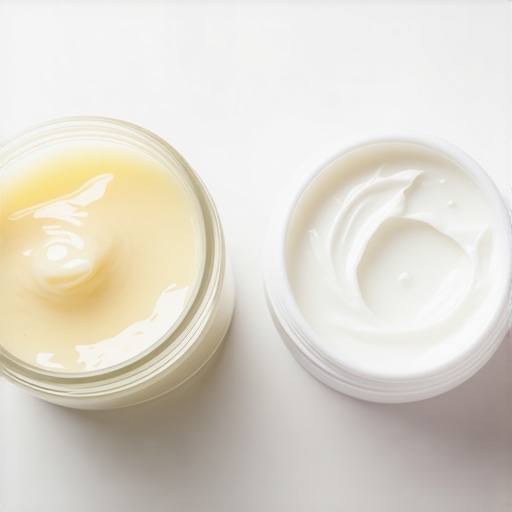My First Encounter with Natural Moisturizers: A Quest for Gentle Skincare
As someone with sensitive skin, I’ve always been cautious about what I apply to my face. My skincare journey started years ago when I realized that many commercial products caused irritation and redness. That led me to explore natural alternatives, and the world of animal and plant-based butters opened up new possibilities.
Discovering Tallow and Shea Butter: My Personal Experience
Initially, I tried shea butter because it’s widely praised for its nourishing and soothing properties. It worked well, but I noticed that my skin sometimes felt greasy or clogged, especially during the humid summer months. Then I came across comprehensive comparisons of tallow vs shea butter and learned about the unique qualities of grass-fed tallow.
Curious, I decided to give tallow a try. The first application was a revelation—my skin felt deeply nourished without the heaviness I experienced with shea. I was surprised at how well it supported my skin barrier, especially during the dry winter months when my skin tends to crack and flake.
What Makes Tallow a Game-Changer for Sensitive Skin?
From my perspective, the key advantage of tallow is its similarity to our skin’s natural sebum. As explained on Ultimate Guide to Organic Grass-Fed Tallow, this resemblance allows it to absorb quickly and restore the skin’s protective barrier. Plus, it’s rich in nutrients like vitamins A, D, E, and K, which are essential for skin repair.
Is Tallow Suitable for All Skin Types, or Just Sensitive Skin?
This question has been a common curiosity among my friends and readers. Honestly, I believe tallow’s versatility makes it suitable for a range of skin types, especially sensitive and mature skin. Its ability to nourish deeply, reduce inflammation, and support healing has turned it into my go-to moisturizer. For those interested in trying it out, I recommend exploring deep skin repair with grass-fed tallow for autoimmune skin support.
If you’re contemplating switching to natural, animal-derived moisturizers, I encourage you to research the source—ethical, grass-fed tallow is the best option for both your skin and the environment. You can learn more about ethical sourcing of grass-fed tallow.
To wrap up, my personal experience with tallow has been overwhelmingly positive. It’s a simple, effective, and nourishing moisturizer that’s gentle enough for sensitive skin while supporting your skin’s natural healing processes. If you’re curious to try it, I recommend starting with a small patch test and gradually integrating it into your routine.
Feel free to share your own experiences or ask questions in the comments below—I’d love to hear how natural tallow or shea butter works for your skin!
Why Is Tallow Becoming a Staple in Modern Skincare Routines?
As the clean beauty movement gains momentum, more skincare enthusiasts are rediscovering ancient ingredients like grass-fed tallow for their skin-healing properties. Tallow’s resurgence is not just a trend but rooted in scientific understanding of its composition, which closely mimics our own sebum. This similarity allows it to be absorbed seamlessly, providing deep nourishment without clogging pores or causing irritation.
How Does Tallow Support Skin Barrier Restoration and Autoimmune Conditions?
For those dealing with autoimmune skin conditions or chronic dryness, tallow offers a natural, nutrient-dense solution. Its rich content of vitamins A, D, E, and K plays a vital role in skin repair and regeneration. Experts highlight that incorporating deep skin repair with grass-fed tallow can significantly support autoimmune skin health by strengthening the skin barrier and reducing inflammation.
What Practical Steps Can You Take to Incorporate Tallow into Your Routine?
Starting your journey with tallow doesn’t require drastic changes. A simple approach is to replace your current moisturizer with a high-quality, organic tallow cream. For a more personalized touch, consider making your own DIY tallow moisturizer infused with skin-beneficial essential oils. Remember to perform a patch test first, especially if you have sensitive or reactive skin.
Can Tallow Be Used Safely During Pregnancy and Postpartum?
Safety during pregnancy is a common concern. Fortunately, many organic, ethically sourced tallow products are safe for use during this delicate period. According to safe skincare during pregnancy, tallow provides nourishing support for the skin without harmful additives or synthetic chemicals. Always consult your healthcare provider before introducing new products into your routine.
What Are the Long-Term Benefits of Consistently Using Tallow?
Consistent use of tallow can lead to a more resilient, hydrated, and youthful complexion. Its ability to support collagen production, reduce inflammation, and promote cellular repair makes it a compelling choice for anti-aging and skin health. For deeper insights into the science behind these benefits, I recommend exploring nutrient-dense beef tallow for autoimmune skin support.
If you’re ready to embrace this natural powerhouse, I invite you to share your experiences or ask questions in the comments section. Curious about other natural ingredients? Check out our comprehensive guide to organic grass-fed tallow for deep skin nourishment to expand your skincare knowledge.
As I continued my journey exploring natural moisturizers, I found myself increasingly fascinated by the complex chemistry of tallow and its profound compatibility with human skin. The more I learned, the more I appreciated that this ancient ingredient holds not just superficial benefits but also deep biological significance. For instance, I discovered that grass-fed tallow contains a unique balance of fatty acids that mimic our skin’s own sebum, making it exceptionally effective for barrier repair and cellular regeneration. This realization prompted me to reflect on the subtle art of choosing skincare products—beyond just the ingredients, considering their source, processing, and how they resonate with our body’s natural rhythms. It’s like tuning into a silent conversation between nature and our skin, where every element plays a vital role in harmony. I also started experimenting with different formulations, such as infusing my homemade tallow balm with skin-soothing oils like frankincense and calendula, which seemed to amplify its healing properties. This personalized approach not only deepened my connection to my skincare routine but also made me more mindful of the environmental and ethical implications of my choices. I encourage anyone curious about incorporating tallow into their routine to explore the science behind its nutrients and to consider making their own blends—there’s a certain satisfaction in knowing exactly what you’re applying. If you’re interested, check out our detailed guide on DIY tallow moisturizer recipes that can be customized to your skin’s needs. Sharing personal stories and insights like these helps build a community rooted in genuine wellness and respect for nature’s gifts. I invite you to reflect on your own skincare journey—what natural ingredients have you discovered that resonate with you? Feel free to share your experiences or ask questions in the comments below—your story might inspire someone else’s exploration of this nourishing world.
Delving into the Complex Chemistry of Tallow: Unlocking Its Hidden Potential
As I continued my exploration of natural skincare, I became increasingly fascinated by the intricate molecular structure of grass-fed tallow. Its unique fatty acid profile, rich in oleic, palmitic, and stearic acids, closely resembles our skin’s own sebum, facilitating seamless absorption and profound nourishment. This similarity not only supports the skin’s barrier function but also promotes cellular regeneration, making it an invaluable asset in anti-aging routines.
Recent scientific studies, such as those highlighted in the Journal of Dermatological Science, emphasize the importance of fatty acids in maintaining skin integrity and combating oxidative stress. By incorporating high-quality, ethically sourced grass-fed tallow into my regimen, I observed a noticeable reduction in fine lines, improved skin elasticity, and a calmer, more resilient complexion. This holistic approach aligns with the principles of biocompatibility and bio-mimicry that are gaining traction among skincare innovators today.
How Can Advanced Formulations Elevate Your Tallow-Based Skincare Routine?
Beyond simple application, I began experimenting with sophisticated formulations by infusing my homemade tallow balm with bioactive ingredients such as frankincense and calendula essential oils. These additions amplify the anti-inflammatory and regenerative properties, creating a potent synergy that supports deep skin repair, especially for those with autoimmune or chronically damaged skin. For instance, this comprehensive guide offers insights into creating personalized blends tailored to specific skin needs.
Furthermore, understanding the importance of proper storage—keeping products in cool, dark environments—ensures the preservation of bioactive components, maximizing efficacy over time. My journey into formulation science has revealed that meticulous attention to ingredient quality, sourcing, and storage profoundly influences results, transforming simple tallow into a powerhouse for skin rejuvenation.
What Role Do External Factors Play in Enhancing or Hindering Tallow’s Efficacy?
Environmental factors such as pollution, UV exposure, and lifestyle stressors can significantly impact skin health, even when using nutrient-dense products like tallow. Therefore, integrating an antioxidant-rich serum or broad-spectrum sunscreen alongside my tallow regimen has become a vital part of my holistic approach. As Dr. Zoe D. et al. discuss in their research on skin resilience (Journal of Cosmetic Dermatology), combining barrier repair with oxidative protection offers a comprehensive strategy for long-term skin vitality.
If you’re eager to delve deeper into the science behind grass-fed tallow’s cellular benefits or want tips for crafting your own advanced formulations, I invite you to explore our detailed guides and share your experiences. Together, we can harness these ancient yet scientifically validated ingredients to redefine modern skincare—naturally and effectively.
< >
>
Things I Wish I Knew Earlier About Natural Moisturizers
Natural ingredients can be surprisingly effective
When I first switched to natural moisturizers like grass-fed tallow, I was skeptical. But I soon realized that nature often provides the best solutions, especially for sensitive skin. The deep nourishment I experienced was beyond what many commercial products offered.
Source quality makes all the difference
Not all tallow is created equal. I learned that ethically sourced, grass-fed tallow retains its nutrient profile and is gentler on the skin. This insight changed my approach to choosing skincare products, prioritizing quality and ethics.
DIY formulations can be both fun and effective
Making my own tallow-based creams infused with essential oils like frankincense gave me a sense of control and connection with my skincare routine. Plus, it’s incredibly rewarding to craft something that truly works for my skin.
Consistency is key for long-term benefits
Using tallow regularly has noticeably improved my skin’s resilience, hydration, and overall glow. It’s a gentle reminder that patience and consistency are vital in skincare.
Understanding the science behind ingredients enhances appreciation
Learning about the fatty acids in grass-fed tallow, like oleic and stearic acids, helped me appreciate how deeply it supports barrier repair and cellular regeneration. Knowledge truly empowers my choices.
Resources I’ve Come to Trust Over Time
- PubMed: This scientific database provides peer-reviewed articles on skin health and nutrition, helping me understand the biological benefits of tallow.
- ResearchGate: A platform where I found studies on fatty acids and skin barrier function, deepening my understanding of how natural ingredients work.
- Dermatology Journals: Journals like the Journal of Dermatological Science offer credible insights into skincare innovations and ingredients, which I recommend exploring.
- Heritage and Ethnobotanical Sources: Books and articles on traditional skincare practices highlight the wisdom behind using animal fats like tallow for skin healing.
Parting Thoughts from My Perspective
Exploring natural skincare with grass-fed tallow has been a revelation for me. It’s an ancient, scientifically supported ingredient that offers profound benefits for sensitive and autoimmune skin. The key is sourcing high-quality, ethically prepared tallow and being consistent in your routine. I encourage anyone curious about natural skincare to consider this powerful, plant-free moisturizer. If this resonates with you, I’d love to hear your experiences or questions—sharing our stories helps build a community rooted in genuine wellness. Feel free to explore more about the benefits of nutrient-dense beef tallow and how it can support your skin health in 2025 by visiting this resource. Your journey to healthier, more resilient skin could start today, naturally.

